Motorola Razr Plus 2024 vs. OPPO Find N3 Flip: A relatively easy choice
The Razr Plus makes a strong argument, but the Find N3 Flip is no pushover.
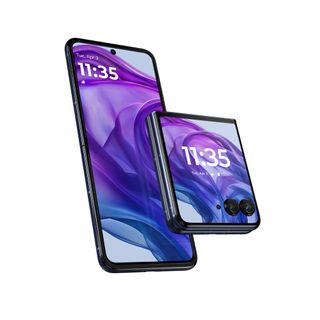
Pushing the envelope
The Motorola Razr Plus 2024 raises the bar yet again for vertically folding phones. It features bigger and brighter displays with crazy-high refresh rates, waterproofing, rapid charging, and high-resolution cameras. Together, with new finishes, speedy SoC, and a slick Hello UX software skin, the Razr Plus 2024 is primed to be the foldable to beat in 2024.
For
- Larger, brighter cover screen
- Powerful chipset
- 50MP dual-rear cameras
- Larger battery with 15W wireless charging
- IPX8 water resistance
- Slick software
Against
- No ultrawide camera
- Lacks dust protection
- Only one RAM/ROM configuration

Triple threat
Oppo's Find N3 Flip provides a unique take on a flip smartphone, featuring a vertical outer display and three external cameras. It's also one of the few foldables to have a minimal display crease. We love its all-day battery life and fast charging, great software support, and quality main display. The only thing holding it back is its availability, which is restricted to only certain global markets.
For
- Superb design and great color options
- Impressive triple camera system
- All-day battery life and fast charging
- Great software support
- Wider display than other flip phones
- Minimal display crease
Against
- ColorOS takes some getting used to
- No wireless charging
- No dust resistance
- Cover screen experience is limited
Motorola Razr Plus 2024 vs. OPPO Find N3 Flip: Design

Motorola is sticking to the 'if it ain't broke' motto with the new Razr Plus 2024, and has added a few refinements to the external design. The aluminum frame and back panel now come in new colors, which is one way to tell the new model apart. You also get unique textures for the back panel, depending on the color you pick. These include Midnight Blue, Spring Green, Peach Fuzz, and Hot Pink. It has very similar physical dimensions as the older model and is only slightly heavier at 189g.
The Oppo Find N3 Flip has the same form factor and is built using similar premium materials like aluminum and glass. It is thicker and heavier than the Razr Plus, measuring 7.8mm when unfolded and with a weight of 198g. The colors are more subtle though, as the N3 Flip comes in Sleek Black, Cream Gold, and Misty Pink.
Motorola Razr Plus 2024 vs. OPPO Find N3 Flip: Displays
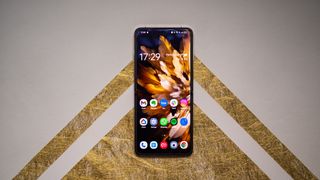
The main folding displays of both phones are similar in size. The Razr Plus 2024 has a 6.8-inch pOLED panel with a 2,640x1,080 resolution, 165Hz refresh rate with LTPO tech, and up to 3,000 nits of peak brightness. This is easily the most impressive folding display we've come across yet for this form factor, making it one of the best foldables phones yet.
The outer display is larger in the new model, stretching 4 inches diagonally. It also takes up most of the outer frame, merging with the cameras. This display too is stunning thanks to a 1,272x1,080 resolution, LTPO pOLED panel with 165Hz refresh rate, and a whopping 2,400 nits of peak brightness.

The Find N3 Flip on the other hand has more modest display specs, but does its intended job well enough. It's a 6.8-inch AMOLED display with a similar 2520x1080 resolution. It too, has LTPO tech for varying the 120Hz refresh rate based on what's being displayed. It has 1,200 nits of peak brightness, with up to 1,600 nits of local peak brightness. What's truly remarkable, is the minimal visible crease, which is usually the bane of most foldables. OPPO credits this to its proprietary Flexion hinge.
The outer 3.26-inch display of the N3 Flip is rectangular and placed vertically on the outside. It has a modest 720x383 resolution, 60Hz refresh rate, and a peak brightness of 800 nits. Durability is ensured by Gorilla Glass Victus.
Motorola Razr Plus 2024 vs. OPPO Find N3 Flip: Hardware

The new Motorola Razr Plus has the recent-launch advantage when it comes to hardware. It's powered by the Snapdragon 8s Gen 3 SoC, which has proven to be a powerful and capable chip, with performance on par with last year's flagship too, in some scenarios. You get just one variant with 12GB of RAM and 256GB of storage, priced at $1,000. We're yet to test this phone, but we're confident that performance is not going to be an issue.
There are a good number of 5G bands in the new Razr Plus 2024, along with Wi-Fi 7 and Bluetooth 5.4. Sadly, the Type-C port is of the older USB 2.0 standard, which is not cool for a mid-2024 smartphone. The phone has a decently sized 4,000mAh battery with 45W TurboPower fast charging (charger sold separately), and 15W wireless charging.
The Razr Plus 2024 gets better water protection with an IPX8 rating, but this comes at the cost of losing dust protection which was present on its predecessor.
| Header Cell - Column 0 | Motorola Razr Plus 2024 | OPPO Find N3 Flip |
|---|---|---|
| OS | Hello UX, Android 14 | Color OS 13.2 (Android 13) |
| Colors | Midnight Blue, Spring Green, Peach Fuzz, Hot Pink | Cream Gold, Misty Pink, Sleek Black |
| Outer display | 4-inch pOLED, 1272x1080, LTPO 165Hz, 2,400 nits peak brightness | 3.26-inch AMOLED, 720x382, 60Hz, 800 nits peak brightness |
| Folding display | 6.9-inch pOLED, 2640x1080, LTPO 165Hz, 3,000 nits peak brightness | 6.8-inch AMOLED, 2520x1080, LTPO 120Hz, 1,200 nits peak brightness |
| Processor | Snapdragon 8s Gen 3 | MediaTek Dimensity 9200 |
| RAM | 12GB LPDDR5X | 12GB LPDDR5X |
| Storage | 256GB UFS 4.0 | 256GB UFS 4.0 |
| Cameras | Outer: 50MP main (f/1.7, OIS) + 50MP telephoto (2x optical zoom); Inner: 32MP | Outer: 50MP main (f/1.8, OIS) + 32MP telephoto (2x optical zoom) + 48MP ultrawide (f/2.2); Inner: 32MP |
| Speakers | Stereo speakers with Dolby Atmos, Snapdragon Sound 4 | Stereo speakers |
| Battery | 4,000mAh | 4,300mAh |
| Charging | 45W wired, 15W wireless | 44W SUPERVOOC wired |
| Ingress protection | IPX8 | IPX4 |
| Wireless | 5G, Wi-Fi 7, Bluetooth 5.4, NFC | 5G, Wi-Fi 7, Bluetooth 5.3, NFC |
| USB | USB 2.0 | USB 2.0 |
| Dimensions | Open: 73.99 x 171.42 x 7.09 mm; Closed: 73.99 x 88.09x 15.32mm | Open: 75.78 × 166.2 × 7.79 mm; Closed: 75.78 x 85.54 × 16.45 mm |
| Weight | 189g | 198g |
| Price | $1,000 | SGD $1,499 (~$1,110 U.S.) |
The Find N3 Flip launched in 2023 with the flagship MediaTek Dimensity 9200 SoC. It's also a 4nm chip like the 8s Gen 3, and performance was excellent when we reviewed it. The phone gets a little warm when playing heavy games like Honkai Star Rail, but that is to be expected. You get 12GB of RAM here too, but two storage variants of 256GB and 512GB. Prices start at SGD $1,499 (roughly $1,110 U.S.), but sadly OPPO hasn't officially launched it in the States.
The N3 Flip has a larger 4,300mAh battery which should, technically, provide better battery life than the Razr Plus. It does miss out on wireless charging though. Thankfully, wired charging is a speedy 44W and the SUPERVOOC charger is bundled with the phone. There's 5G support, Bluetooth 5.3, Wi-Fi ac, NFC, and a USB 2.0 Type-C port.
OPPO's N3 Flip gets a big upgrade over the N2, with an official IPX4 rating for moisture protection. It's not as sealed-off as the Moto, but is a definite improvement over the Find N2 Flip.
Motorola Razr Plus 2024 vs. OPPO Find N3 Flip: Cameras

The OPPO Find N3 Flip has the most versatile set of cameras here, cramming wide, ultrawide, and telephoto lenses on the outside. In our review, we found that images shot in daylight looked good in general, but the output was a bit soft. The 32MP telephoto offers 2x zoom, and the output is quite impressive. Shots taken in low light are decent too, but there's some noise present. Video recording tops out at 4K 30fps, but is limited to 1080p when recording using the cover display as a viewfinder.
Motorola has made a bold choice by ditching the ultrawide camera in favor of a telephoto for its outer dual-lens setup. Both are 50MP cameras, which means we can expect good-quality photos. Motorola's flagships tend to deliver good low-light performance too, thanks to a well-tuned Night mode. There's a 32MP selfie camera here, similar to what you get in the N3 Flip.
Motorola Razr Plus 2024 vs. OPPO Find N3 Flip: Software
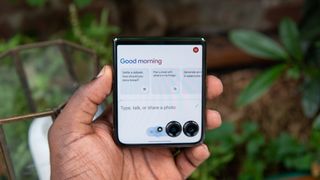
Motorola and OPPO have taken quite different approaches to software. If you have a ton of features to a point where it's actually overwhelming, you'll love the ColorOS software in the Find N3 Flip. The phone launched with ColorOS 13.2 based on Android 13, but has rolled out the next version based on Android 14, this June. Be prepared to deal with many redundant apps and some bloatware if you pick this.
The N3 Flip has the usual software tweaks that come with a foldable of this nature, allowing you to perform additional tasks in some apps when you have the phone folded halfway. The outer display even lets you open certain apps in full screen, but it's not as well implemented as the Razr Plus 2024. Typing out messages is also tricky with the narrower display.
The Razr Plus 2024 ships with Android 14 out of the box, and is scheduled to get three years of OS upgrades. We'll have to wait and see if Motorola is more prompt with updates this time, as it doesn't have the best track record. The Razr Plus 2024 has its own lean skin over Android called Hello UX, and it will be getting a host of AI features later this year through an update.
Motorola Razr Plus 2024 vs. OPPO Find N3 Flip: Which one should you buy?
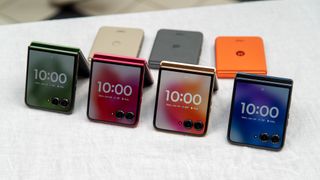
As much as I love the triple camera setup of the Oppo Find N3 Flip, I'd have to put my money on the Motorola Razr Plus 2024. The large and more useful outer display and the lean flavor of Android are the two biggest reasons why you should buy it. Global availability is also much better, as it is simply sold as the Razr 50 Ultra in other countries. It comes in more attractive colors and finishes, the display specs are simply outstanding, and it has a powerful processor that should age well.
I'm sure there are some folks who would prefer the Find N3 Flip for the wireless charging support, ultrawide camera, and larger battery. However, given that's more expensive than the Razr, it gives you less value for money.
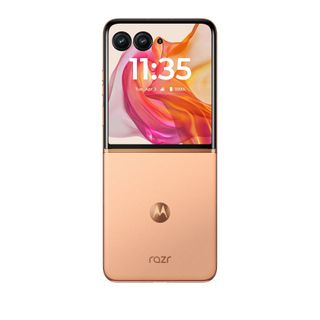
Setting the bar real high
In the world of flip smartphones, the Motorola Razr Plus 2024 is the one to beat. It packs (nearly) everything one would want in a modern flagship, and it doesn't hurt that it looks so darn good!
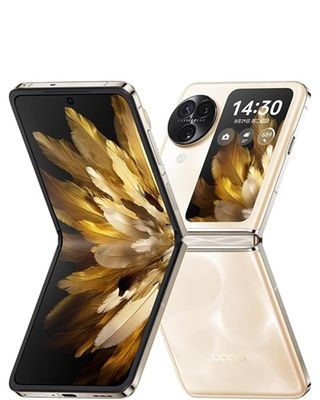
Unique in its own right
The OPPO Find N3 Flip should not be dismissed that easily, as it's still one of the few flip phones with a barely visible crease. It also has three outer cameras, which is impressive for this form factor. If it's available where you live, it could be a better deal if you can find it on sale.
Be an expert in 5 minutes
Get the latest news from Android Central, your trusted companion in the world of Android
Roydon has been writing about consumer tech for over a decade, and has reviewed a wide variety of products, from TVs and headphones, to cameras and PC components. Smartphones and laptops have been his main focus areas for the past couple of years, where he has extensively covered both spaces in terms of reviews, features, interviews, and live events. When not helping someone pick out their next phone, you’ll find him hunting for new TV shows to binge watch, and struggling to complete his backlog of PS4 games.
-
junk14580 Reply
That RAZR has been truly disappointing - Since January users have to open the phone to use Google Assistant properly, and Moto is not even committing to fix this critical user-function, despite still advertising that Assistant can be used with the phone closed. It is a serious defect for a phone that promotes usability when closed. The Lenovo/Moto/RAZR support/discussion board shows how little Moto is taking any responsibility of a broken feature Moto specifically promotes. Moto RAZR... outrageous you have to open the phone to use Google Assistant, awkward, not as advertised, more wear on the hinge and screen fold... since Jan '24 - still that way in July - that 25% of a phone's typical use life a critical SW function is broken. Great idea, but someone dropped the ball on this critical function.AC News said:Motorola has given the new Razr Plus 2024 many meaningful upgrades like a larger cover screen, proper waterproofing, and new cameras. But OPPO's Find N3 Flip makes a strong case for itself too as it goes head-on with the new Moto.
Motorola Razr Plus 2024 vs. OPPO Find N3 Flip: A relatively easy choice : Read more
